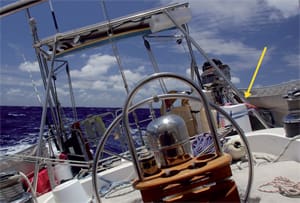Only a year ago, this is how we would have answered the following questions about the life rafts on our boats.
Q: “Is your life raft past its servicing due date?”
A: “Yes.”
Q: “Do you know when or where you’ll get it serviced?”
A: “Well, not exactly.”
These are just a couple of the questions in a survey we recently conducted with 14 other experienced voyagers regarding their life rafts. On our boats Momo and Totem, we knew (separately, having only recently met) that our respective rafts needed servicing — but we both ran into issues getting that servicing done.
We’ve since serviced our rafts, but the process raised many questions. Thus, from our relatively comfortable-but-still-curious, ex post facto vantage point, we contacted more than a dozen other ocean-going sailors about their life rafts and their experiences with both equipment and vendors. We first asked how they chose their rafts, and their considerations were mainly what you’d expect: brand reputation, reviews, pricing, availability and recommendations by others. For those whose life raft came with the boat, the decision was primarily about whether to change it. In other cases, geography played a role, limiting selection to fewer available and affordable products. When those constraints did not exist, sailors focused on other criteria, selecting life rafts based on the size of the case and where they could be mounted.
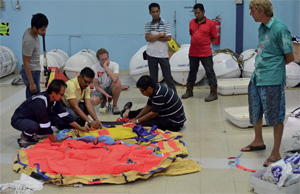 |
|
Jamie Gifford (white shirt) and fellow voyager Bernie Heise (far right) look on as service center crew prepare to inflate a life raft. |
|
Behan Gifford |
It’s the serviceability, sailor
Of the long-term sailors we interviewed, only two out of 16 considered serviceability when purchasing their life rafts. Bill Babington, who single-hands his Liberty 458, Solstice, purchased his Revere life raft near his departure date specifically to avoid servicing issues as he made his way around the world. Meanwhile, Nadine Slavinski, who for eight years sailed her Dufour 35 Namani with her husband and young son (and who has previously written on the subject of life raft installation in the 2012 issue of Ocean Voyager), explained that she and her partner Markus Schweitzer chose their Viking RescYou six-man raft specifically for ease of serviceability: “We wanted one that only needed servicing every three years — our previous needed every year — and could be serviced around the world, including Australia.”
Apart from Bill and Nadine, however, none of the other sailors gave the issue of servicing much thought. Yet the overlooked question of servicing gains intensity over time: the longer you sail your boat and the further afield you go, the greater this issue becomes. For long-term and long-distance sailors, when and where to service the life raft will eventually become key questions.
Two boats, two similar stories
Momo and Totem are both outfitted with the same life raft, the Winslow six-man Superlight Offshore Plus. Both their crews have been traveling and living aboard with children for years. Both crews intended to service their respective life rafts in Singapore, at the official Winslow-sanctioned servicing center. And, when the time came, both decided against servicing in Singapore — quite independently, as the families aboard had never met prior to encountering each other in Malaysia.
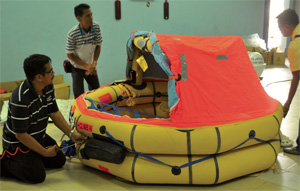 |
|
A raft nearly inflated. Raft should be inflated using compressed air, not the raft’s CO2 canister as repeated CO2 inflations can damage the raft material. |
|
Michelle Elvy |
So, why didn’t we opt for the official servicing site? And how did we end up essentially making the same set of decisions, after years of sailing different routes that happened to bring both boats to the same harbor one sunny day?
Well, to begin with, the criteria according to which we purchased our rafts were remarkably similar: the Winslow’s effectiveness, reliability and reputation played a major role in reassuring Totem’s and Momo’s purchasing decisions. But neither of us factored in the servicing component. So when we found ourselves halfway around the world, facing decisions about where to service our Winslows, convenience and availability suddenly became two new important criteria.
Considering the service center
In order to look beyond the particulars of our own life raft company, we contacted a number of the top-name life raft manufacturers to ask about their servicing centers. We discovered that most have only a handful of centers outside North America and are not forthcoming when it comes to directing owners to non-nominated facilities. “We only sell parts to approved [brand name] service facilities,” was a typical manufacturer response to our query. Others cited the need for properly trained technicians, and pointed out that the warranty is automatically voided by using non-certified facilities.
Totem’s crew chose not to use the Winslow-nominated center for various reasons; the final decision was reached after witnessing how the center handled certification for another boat, which cast doubt on the overall process. In that case, final fees increased 239 percent from the initial quote. The additional charges ranged from the surprising (numerous services and items that one might reasonably expect to be standard but were not included the original estimate, such as a re-inspection certificate, floor seam test, exterior label and new vacuum bag) to the unreasonable (astronomical markups on packed items such as flares). Indeed, there was a profound and seemingly deliberate lack of transparency about 1) what the initial quote actually covered, and 2) the prices for those services and items excluded by the basic service.
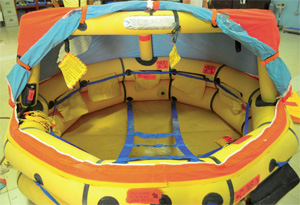 |
|
It’s sobering to look at an inflated raft and contemplate using it. |
|
Michelle Elvy |
Meanwhile, just as Totem’s crew were facing the conundrum of what to do with their life raft, Momo arrived in Puteri Harbor, having ascertained that there was a servicing center nearby in Malaysia. The idea of using someone local and relying on a center where we could witness the work, combined with Totem’s stories, convinced both couples to check out this Malaysian safety center. And, although Semangat Fire Safety typically deals with much larger vessels than Totem and Momo, the company did not disappoint. They welcomed our participation, and we had the invaluable experience of watching our rafts inflated. We examined the material, seams, CO2 canister, and contents. We discussed with the staff what we did, and didn’t, need to have re-packed, approving additions and replacements. Service was prompt and we felt comfortable with the facility, people and the quality of work.
In our survey, others also remarked on the reassurance that comes from witnessing your life raft’s servicing first-hand. Joe McKeown, who built his 50-foot boat Shanachie, a custom cold-molded Paul Whiting design (NZ), back in 1981 and has been sailing her across oceans ever since, has always been present at his life raft inspections. When asked whether he recommends being present for servicing, he answered, unequivocally, “Always. Good idea to explore the premises to see if they have the correct gear for repair and servicing.”
Gina Rae, who has logged many bluewater miles between New Zealand and the U.S. on Solace, her Hylas 44, agreed. She was present both times when her life raft was serviced. She reported: “Both facilities were clean and tidy and allowed us to participate fully. We got to deploy [the raft] both times and get in, and see how they inspected it. We also watched the emergency packs being put together.”
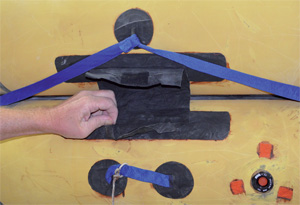 |
|
Conduct your own inspection. |
|
Behan Gifford |
Jim Wilson of Ceol Mor, a J42 he circumnavigated with his wife and two sons, added that watching the inflation of his life raft in the facility in New Zealand was an “extremely valuable experience.” He emphasized: “This particular facility was clearly equipped to handle servicing, and we were able to see many different things that could be done to refurbish or repair rafts.”
Confidence in brands and promises
Which brings us to a major point: the life raft is a piece of essential equipment for many of us sailors, but, as with many things, the raft is only as good as the people behind it. The servicing of a life raft is as important as the raft itself. David Cowper, a record-setting British mariner who has sailed around the globe in both directions, and who was the first to circumnavigate single-handed via the Northwest Passage (which he’s done numerous times by now, starting when it was less fashionable and much more difficult), sails Polar Bound, his 48-foot custom aluminum vessel designed for serious polar voyaging, with an emphasis on safety. When we asked him about the element of trust that’s intrinsically involved in servicing one’s raft, he talked about the danger of relying on the kindness of strangers who may just be a little blasé about the task at hand. “The problem is you have to have complete faith in the person carrying out the service in a job where repetitive boredom creeps in,” David told us. “It would be useful for these places to have large signs on their walls reminding staff that people’s lives depend upon their thoroughness and dedication.”
Ultimately, your safety depends on the human factor, not just the equipment. And, when you look into safety servicing companies, you quickly discover that official company statements do not always jibe with reality. The Giffords on Totem based their purchase decision in part on the expectation that, when the initial servicing was due, they would be in Australia — a continent boasting one of Winslow’s handful of recognized international service centers. However, three years later, even though the service vendor was still listed on Winslow’s website, the Giffords were told that the center was no longer “certified” for Winslow rafts and had not serviced such a life raft for a few years. The center would not look at the Giffords’ raft, leaving them without a viable alternative.
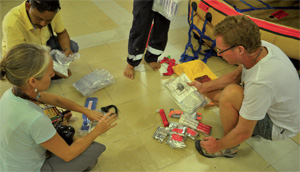 |
|
Behan and Jamie Gifford check their raft’s contents. |
|
Michelle Elvy |
We should point out that the life rafts aboard Momo and Totem are well beyond their warranty period and that the Winslow warranties are no doubt voided by the fact that we used a non-Winslow approved servicing center. But we aren’t as concerned about corporate guarantees (which won’t be very useful in a life raft deployment situation) as with the assurance that comes from carefully examining the raft and its contents in a hands-on manner: seeing the servicing center, watching the raft being inflated by qualified professionals, examining and replacing its key contents, and knowing the people who un-packed and re-packed the rafts. That experience makes us better informed, and being well informed puts a sailor at ease.
Servicing realities
Disappointment with servicing was a common theme among the sailors we interviewed, with more than half commenting on hefty fees. Jon Hacking of Ocelot, his 48-foot Kronos Wauquiez-designed catamaran and family home since 2001, reported that the initial quote agreed upon for servicing his life raft in Mooloolaba was far exceeded by the subsequent work.
Jim Wilson recalled being “shocked” at the $1,500 he paid for his initial servicing: “I asked for a cost breakdown and found that many of the things that were thrown out were inordinately expensive when replaced — batteries, water and simple things were absurdly price.” This, even though the servicing occurred prior to expiry for many included items.
Doug Scott noted the high fees he paid as well, saying, “$1,300 seemed a bit excessive for the work involved.”
Jan Schwab of the Islander Freeport 41, Slipaway, which she’s sailed with her husband Rich for more than a decade, agreed; she’s not at all convinced that the price she paid for their servicing was what she’d consider “fair.”
Joe McKeown notes that even dealing with customer service upon purchasing his life raft was tricky, with issues arising between “usual promises and problems with actual delivery date, correct size to fit existing deck bracket and delivery to the boat.”
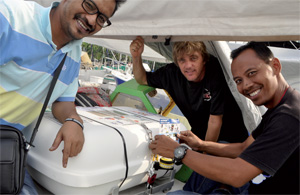 |
|
Bernie Heise of the sailboat Momo with the friendly crew from the life raft service center in Johor Bahru, Malaysia. |
|
Michelle Elvy |
Others we interviewed had more positive servicing experiences. Jim Wilson of Ceol Mor stated that, even though he was “outraged” by the pricing of the facility in the U.S., he felt good about the quality of work and could tell the raft had been packed well when it was unpacked at the next servicing in Wellington, New Zealand. Furthermore, he was also impressed by the quality of service in Wellington, New Zealand — at a brand-certified facility that delivered excellent results with agents of significant experience.
Mark Morwood of the Catana 48 Por Dos, which is the third ocean-going boat he’s sailed with his wife and two sons, reported that the service he received at LRSE in Rhode Island was professional and excellent, living up to its reputation.
Jan Schwab was also mostly satisfied with the service in both Norfolk, Virginia and Auckland, New Zealand — but she notes, cautiously, that she has not really tested the quality of work and, like us all, hopes she never has to.
Trust in the service provider — or “faith,” as David Cowper emphasized — is critical. One couple we agreed not to name told us the story of how they worked with the registered agent in Auckland to service their raft and found out later, when inflating it in a yacht club pool before replacing it with a new unit, that the vendor had used duct tape to repair seams instead of the proper glue and materials. “We saw clearly how temporary and last-resort these life rafts are, so that’s a lesson in itself,” they told us. Another boat shipped their raft to an international service provider, only to have the returned case closed with — you guessed it — duct tape instead of a rubber seal. Re-servicing was necessary, at which point they found that their personal items inside (sunglasses, fishing gear and cards) were missing.
Doug Scott of the Tayana 4, Moondance, sums it up succinctly: “You never really know about the quality and trust until you need to deploy the raft.”
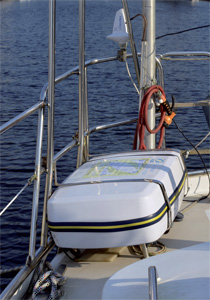 |
|
Stern-mounted life raft on vessel in Puteri Harbor Marina. |
|
Behan Gifford |
Lessons learned
So, what have we learned? Well, at the very least we’ve gained knowledge and experience about rafts and their care, and about the disconnect that sometimes occurs between official corporate literature and reality. And we now know how we’ll tackle the servicing issue next time it comes around.
The main thing to keep in mind is this: the life raft is more than just a piece of equipment — it’s an essential silent partner. While it’s important to choose a quality product in the first place, care and servicing matter as much as the raft itself. In the words of Jamie Gifford of Totem, your life raft is “more than two four-letter words.”
Michelle Elvy is a writer, editor, and manuscript assessor originally from the Chesapeake, now based in New Zealand and currently exploring Southeast Asia. She has been living aboard and sailing with her husband and children for twelve years. Behan Gifford is a freelance writer and photographer with a focus on travel writing and the boating industry. For the last six years, she’s lived on her 1982 Stevens 47 sailboat Totem with her husband and three children.

